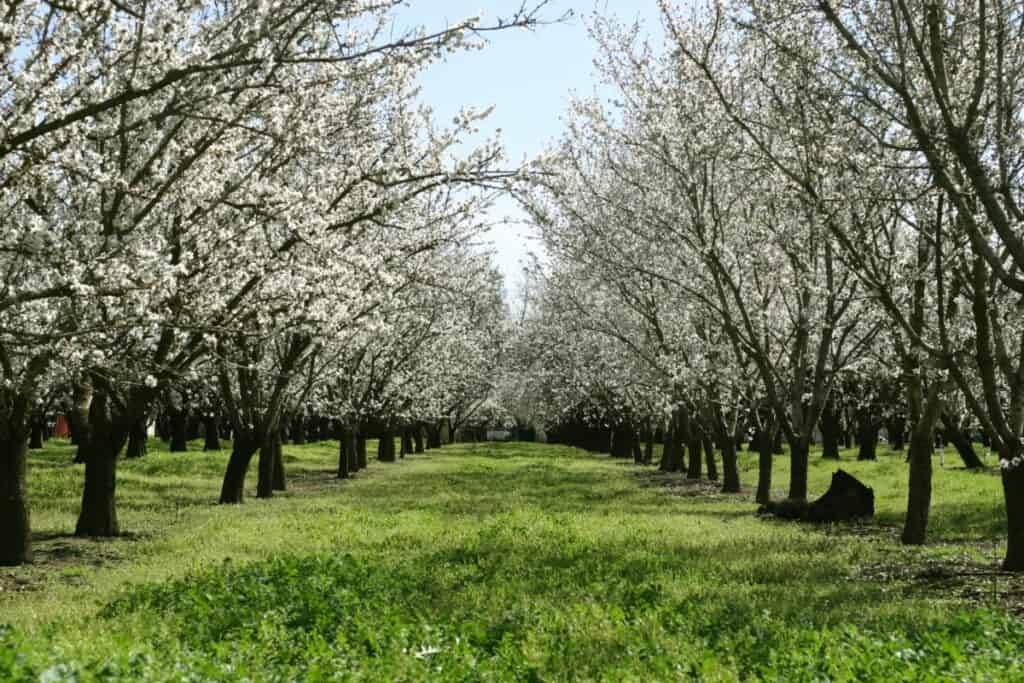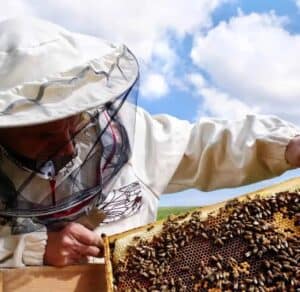How Much Money Do Beekeepers Make For Pollination Services?
Bee pollination is a large industry, especially in California. They are used for many things but most of the pollinators’ business comes from almond farmers.
On average, a beekeeper will make $49,232 for their pollination services. However, this salary can differ based on multiple components, including but not limited to: the type of crop being pollinated, the amount and size of hives needed, traveling distance, price of gas, and supply versus demand.
Bees are the primary form of pollinators in the United States. They are extremely necessary not only for nature but for agricultural (crop) production and provide a lot of money for the nation’s economy every year.
How Much Is Honey Bee Pollination Worth?

Honey bees are the single most valuable agricultural pollinators. The United States Department of Agriculture declared that one hive of honey bees is 100 times more valuable to the community than to the pollinator/ beekeeper (in the sense that what the bees provide exceeds what their actual price is). It’s cool that they said that because it goes to show that pollination is honestly priceless.
In the United States alone, the industry of honey bee pollination accounts for $15 billion of the $24 billion that the nation’s pollinators make as of 2014. The total pollination income for 2021 was $269 million, which is 6 percent more than in 2020.
How much money do pollinators make?
According to the Economic Research Institute, the average yearly salary of someone who sells pollination services is $49,232, and this was updated in August of 2022.
In 2010, a beekeeper would receive up to $150 per colony to pollinate almonds. However, it was noted that these pollinators only end up getting about 5% to 10% of their gross income. According to The Bee Corp, as of 2022, the average price for almond pollination is $203. The low end is $165 and the high is around $260.
How much a pollinator will make depends on how much they charge for the distance they have to travel, the price of gas, and their personal availability of bees. If the customer wants 200 hives of bees and the supplier only has 250 hives, they are probably going to charge more than someone who has 3,000 available hives. The pollinator’s supply versus the demand of the customer will strongly influence the profit they make.

Which crop uses the most bees for pollination?
Almonds are the crop that uses the most bees for pollination. This crop completely depends on bees, without them the tree can not produce nuts. This means that where there are almonds, there are plenty of bees. Because beekeepers tend to rent 2 colonies of bees per acre. At the time that this article was written (2010), there were 615,000 acres of almonds in California. In 2020 it was updated to be 1,600,000 acres of almonds in California. With these numbers, it seems nearly impossible that there would be enough bees.
For this reason, 2.1 million beehives were imported in 2021, coming out to approximately 42 billion bees in total. According to Jacob Wenger (Assistant Professor of Entomology at California State University, it is estimated that even more bees than this will be required for almond production in 2022. The Chief Scientific Officer at the California Almond Board stated that for 2022, 3 million bees are recommended, 2.5 million of which would need to be imported.
California’s almond industry alone uses approximately 60% of all the beehives in the country.
How much is a hive for pollination?
Hive rental fees can range from a low of approximately $45 to a high of around $200, this is the cost per colony/ hive of bees. This price can depend on how large the hives are, a beekeeper who is just starting might have colonies with only 5 frames as opposed to a larger scale keeper who has colonies with 10 frames each.
There seems to be a trend that the cost of beehives is rising. In 2003 beehives were about $50, then rose to $150-$175 in 2009. Then, in 2014 the approximate value of each beehive in the United States was $200, but a collective loss of about 10 million colonies drove up the cost even more. As of December of 2021, the projected price for almond pollination was $203 on average per hive.
Bee pollination service prices
Bee pollination service prices will also vary greatly. From a consumer’s perspective, the price will depend on your demand and supply, how far they would need to travel and the cost of gas for it, and the type of crop being pollinated. The colony strength requirement (what size frame is needed/ provided for the job) is also a primary determinant of how the bee pollination services will be priced.
Almond Pollination Cost
Considering that 60% of the nation’s bees are used for almond production, looking into the price of almond pollination is worth it because with a majority like that, it is most likely that the pollination pricing of this crop is what will be applicable to the situation.
A review of almond pollination was done by faculty and a Ph.D. candidate from UC Davis and Louisiana State University. It provided a survey to beekeepers asking the respondents to report the charges associated with their biggest almond pollination service in 2021. 46% of responses stated that their average colony strength requirement is 8 frames. This makes up the majority of beekeepers (that reported) which means this same category of colony strength (8 frames) would predict the average almond pollination charge. This majority of 46% has an average pollination fee of $192.05 per hive.
This study was published on December 14, 2021, and reported charges for almond pollination ranged anywhere from $130 and $225 per colony. As of 2022, it is reported that the high is $260 and the low is $165. The average cost of honey bee pollination for almonds in 2022 is $203. There is a trend in the steady increase of the price of bees, for 3 years in a row, it has increased.

Joseph Davis
My goal is to show that anyone can take up beekeeping and it can be a very rewarding hobby. I strive to share my experiences and answer any questions you may have.
